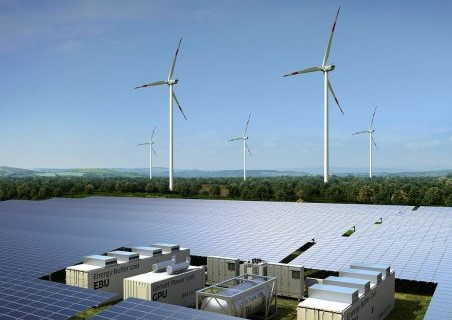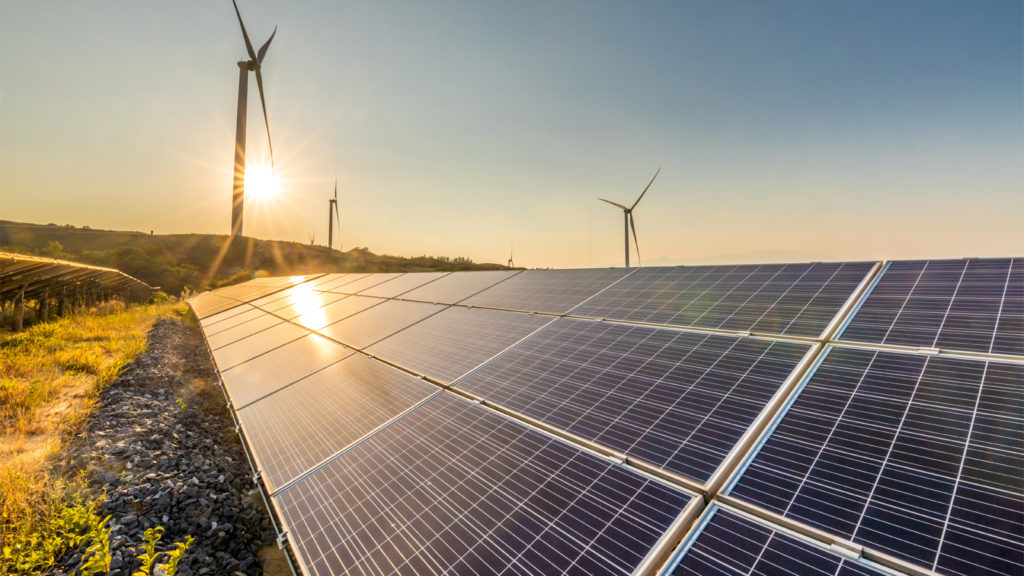Hybrid renewables are playing a strategic role in accelerating the decarbonisation of power generation and supporting the Paris Agreement and the United Nations Sustainable Development Goals (SDGs), as well as supporting the UK’s net zero by 2050 ambition and its interim emissions reduction of 78% by 2035. Peter Lo, Onshore Renewables and Storage Sector Director at ITPEnergised, discusses the UK’s own emergence into the hybrid energy sector and how it is better for our planet, better in the economics and better for offtake.
The whole world is heading towards net zero, in a move towards clean energy, which, in addition to its environmental impact, has a technology, regulatory and economic impact. We have seen serious momentum about hybrid renewables in mainland UK in recent years, and have a history going back even further to some of the early success cases in remote island areas of Scotland from 15 years ago. We are led to believe by market behaviour that hybrids will become the new normal for all renewable energy system developers.
A hybrid renewable power plant typically comprises more than one renewable generating plant, with or without energy storage using the same grid connection point and with some kind of overarching control system.
A similarly used term; “colocation,” is similar to hybrid renewables but tends to have independent control systems. For developers, hybrid power projects offer significant gains, such as helping to share key capital costs such as the primary grid connection, improving the generation profile, reducing balancing costs and making better use of land with higher renewable energy densities. Whilst there are challenges that can be identified, and often mitigated, hybrid renewables are better for our planet, and bridge an execution gap in a status quo plain vanilla organic development strategy.
Evolution of hybrid renewables in the UK
It is a global phenomenon that when there is increasing intermittent renewables generating, or not generating, on transmission/ distribution grids there is a corresponding stress placed on our legacy design of grid infrastructure. This critical infrastructure that transports electrons, with such strong correlation to country economic success, hasn’t changed much from over a century ago. This backbone of prosperity was really designed to transport “stabilised at source” and “more balanced” fossil fuel generated electrons.
A hybrid renewables plant can help alleviate this grid pressure by “self-balancing” at the point of grid connection with the negative correlation between wind and solar PV generating patterns. Additionally, this relationship helps hybrid renewables plant achieve typical load factors of 50%+ in Europe and over 90% in some parts of the world. Large markets for hybrid renewables include Australia, India and the US. And India’s policy making has been ahead of the curve with solar PV-wind hybrid developments being released by their Ministry of New and Renewable Energy (MNRE) in 2018 along with hybrid specific auctions. A key driver here is more efficient use of the transmission system. Australia’s hybrid renewable power plant, at large scale, is emerging with stricter grid requirements.
With rising standalone intermittent renewables there is also an associated balancing cost which has been growing in recent years, including for our recent Covid-19 lockdowns (with less consumer demand and higher renewables generation). This results in more non commodity balancing costs that form a greater portion of electricity bills, ultimately paid for by consumers. Successful hybrid renewable generation is all about collaboration, typically using a common digital platform that allow interoperability, data insights and optimisation to real time markets according to predefined rulesets which can be reconfigured over the asset life. In nature, then, we are harnessing wind and solar PV resources together in a new collaboration of the elements; rather than letting them compete against each other, as with the Aesop fables of old.
In the UK, there is a trend to develop and implement wind-solar PV-storage technologies in various combinations in the same location, utilising the same grid connection at the planning stage by all types of investors; and also for conversion of operational sites typically by larger utilities. With net zero ambitions, sending a clear long-term investment signal to the market, the UK has much more inflow of new capital and new entrants coming to the market, in addition to the incumbents. In the UK, the development pipeline has burgeoned; with the pipeline for wind and storage almost doubling in less than six months.
Oppotunities for hybrid renewables
Wind-solar PV and wind-solar PV-storage projects are great for our planet as they address scarcity issues with respect to land and grid connection and can reduce balancing requirements which are often provided by more carbon intensive, but flexible, gas fired power generation. With renewable generator and energy storage costs falling, hybrid systems are also expected to become increasingly cost competitive. Recent analysis has included cost parity with base load coal fired plant within a few years with declining capital costs for solar PV and storage, for example, which really has a basis to change the investment decision in certain parts of the world in the future.
Hybrid renewables are great for economics. By adding solar PV to a wind portfolio in sharing the same grid connection, the solar PV part of the scheme could enjoy enhanced economics. If the solar PV scheme added does not pay for the primary grid connection capex, then the solar PV scheme may enjoy an up to 1.7x increase in value and up to a 2% increase in returns. Additionally, owners can increase returns in lower wind energy yield years, diversify risk at the point of connection, and outperform their current ESG proposition with higher renewable energy density for given land use.
Hybrid renewables close an execution gap in plain vanilla portfolio development strategies. Developers will be potentially generating faster future cash flow as hybrids have the possibility to be executed much more rapidly than the typical development cycles for offshore wind (often with substantial multi-year wider grid reinforcements necessary to evacuate the power of the proposed scheme), standalone wind or solar PV project development cycles, as grid connections become more scarce, more expensive and take longer to implement. Hybrid renewables development or conversion for an existing single renewable technology class can therefore be a good parallel tactical play to building out near term clean capacity and adding value.
Hybrid renewables provide a more stable offtake. With the relationship between wind and solar, a flatter generation profile is developed which is more useful to a typical offtaker of power. This is a key benefit as the profile more resembles a base load pattern.
Hybrid renewables are great for “sweating the asset”. Placing solar panels on the flat terrain between wind turbines, offers a better use of land bank, increasing renewables energy density and is more environmentally efficient, enhancing ESG credentials. When locating resources in this way, a developer can maximise the use of their grid connection, instead of seeing this critical asset being stranded for most of the time in single renewable technology operational configurations, much higher capacity factors are achieved in hybrid mode. This can potentially be augmented further by adding storage technologies to the mix.

Trends and types of hybrid renewables projects
We are seeing various iterations of hybrid projects in the UK, but the most typical combinations are storage-ready onshore wind/solar PV and wind and solar PV projects at the consenting stage, and operational onshore wind farms that can convert to hybrid by adding solar PV between the turbines, operational solar PV farms that can add storage, and operational storage that can add some form of solar. There are also other technologies being developed or added such as green hydrogen, EV charging and heat pumps etc.
Essentially, the hybrid then acts as an integrated and interoperable smart energy platform with an overarching digital control layer which is then ripe to adapt to the market as it evolves providing a means to access option value and also to test innovative pilots that can then scale across a portfolio. The platform is also data rich providing insights in real time and beyond that can be additionally augmented with artificial intelligence and machine to machine learning, opening up further value adding opportunities without human manual intervention.
Hybrid renewables are also strongly suitable for green hydrogen market applications as the higher capacity factor can mean a more stable baseload production of green hydrogen for applications in energy, transport, and heating elsewhere in the value chain, helping net zero aims in a more rounded fashion. The green hydrogen route can also make marginal hybrid projects more economic where there are grid constraints for export of full capacity as a proportion of the clean power generated can be consumed locally in the electrolyser and the hydrogen stored or exported as required.
Key planning considerations
Developers are increasingly more forthcoming and better-informed on the process to set up a power plant or retrofit an energy source to existing development. But here are some key considerations to give the best chance of swerving the deal-breaking issues.
The main phases that we prepare developers for at the outset of hybrid conversion project planning are; existing portfolio dataset identification, existing portfolio screening, quantum and type of retrofit renewables and storage, red flag feasibility, deep dive feasibility, valuation and investment thesis, financial investment decision and then into the longer cycles of development, construction, and long term operations. Every phase needs to be considered methodically and our robust gated decision-making framework enables analysis in the right way at the right time to grant access to the subsequent stage.
Screening and feasibility are significant stages for investment of time and planning. There can be challenges associated with existing financing of operational projects, particularly when retrofitting to hybrid renewables but this is not unsurmountable. This explains why the large utilities are successfully retrofitting to operational assets as is the new-build sector, which has freshly financed assets. The forecasted versus the actual operational costs can be quite different and foreseeing or offsetting potential problems with an energy consultancy can be helpful.
With regulations, the path for standalone solar or wind or storage is easier to quantify and more widely understood within a rich data environment. With hybrid renewable schemes, the templates are still evolving. But, as we have seen in the past, the regulations catch up and adapt to new standards of normal and market evolution. This should be no different to cater for the surge in hybrid renewables plant development.
Route to market challenges can include power purchase agreement (PPA) structures, which are complex. Even with a single power plant, such as standalone solar or standalone wind, these PPA structures can pose a conundrum. The basis of a project is decided on months of careful consideration of various factors of value and risk. Hybrid PPAs are being developed globally in various configurations such as solar and battery storage and wind-solar offering a blend of the best of the individual component characteristics and matching these against a business’ energy consumption profile. Some of the capacity can be set aside for merchant exposure also with consideration of the balance of risk and reward.
With net zero ambitions strengthening across the globe, we are living in unprecedented times. At no other point in history does it feel that there has been such marked investor, legal and societal drive to protect our planet for generations to come. As we detach from a legacy carbon intensive world and reorganise for net zero, our decision making in the next few years will decide how well we succeed.
In this new era, I believe our multi-industry challenges will be solved through greater clarity and communication of the challenges to be solved, tangible actions that are marked by greater collaboration over competition, open innovation over guarded intellectual property, and interoperability over silo operating systems. Hybrid renewables are one of mother nature’s intended routes to serving our energy needs and helping our nations prosper in a net zero future.
This article recently featured in Energy Storage News.

